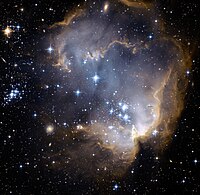Wikipedia:Featured picture candidates/NGC 602
NGC 602



- Reason
- Natural beauty
- Articles this image appears in
- NGC_602
- Creator
- NASA, ESA, and the Hubble Heritage Team (STScI/AURA)-ESA/Hubble Collaboration
- Nominator
- Flex (talk|contribs)
- Support original — Flex (talk|contribs) 20:23, 9 February 2007 (UTC)
- Oppose. As much as I like these NASA pictures, there are already a bunch of astronomy-related pictures here. JHMM13]
 20:39, 9 February 2007 (UTC)
20:39, 9 February 2007 (UTC) - Oppose. While I don't mind that we have "a bunch" of similar pictures, this PARTICULAR one doesn't strike me as terribly exceptional. --Dante Alighieri | Talk 00:16, 10 February 2007 (UTC)
- Support original. oppose edit Yeah we got a bunch of astronomy-related images, but this one is easily on par with them. I'd like to hear in astronomy terms what makes this one different from Orion Nebula and Crab Nebula. ~ trialsanderrors 21:20, 10 February 2007 (UTC)
- Support. I have uploaded a higher resolution version compressed from the TIFF file at [1]. There is some noise but I think that it is acceptable as the subject is about 1,890,000,000,000,000,000 kilometres away. --KFP (talk | contribs) 02:15, 11 February 2007 (UTC)
- Support original. oppose edit — I thought it was 1,854,263,570,000,000,000 kilometers away! ♠ SG →Talk 06:22, 12 February 2007 (UTC)
- Weak support Awesome in full size. You don't see many galaxies through the Orion nebula! Support is weak due to the graininess of the image. --Janke | Talk 16:54, 12 February 2007 (UTC)
- Comment - I guess people here aren't aware of the baby's face in this image? It's looking downwards and to the right, nostrils, chin, closed eyes and forehead are all visible. Stevage 02:50, 13 February 2007 (UTC)
- Uhh, OK. I'm sure that adds to the enc value -Fcb981 05:39, 13 February 2007 (UTC)
- hehe. People will support for baby's face. But I see a skeleton head look downward to right. Or maybe a boy. But we can see it in many ways. And that has a very "high" enc value per Fcb981.--Arad 00:51, 15 February 2007 (UTC)
- Uhh, OK. I'm sure that adds to the enc value -Fcb981 05:39, 13 February 2007 (UTC)
- Support--Meno25 13:22, 13 February 2007 (UTC)
- Support Pacman version ;) Seriously though, rather encyclopedic picture that looks great.--Lewk_of_Serthic contrib talk 13:59, 13 February 2007 (UTC)
- Conditional Support If someone would get rid of those annoying stars and just have pacman :) (just kidding, support) --frothT 18:45, 13 February 2007 (UTC)
- Edit 1 Info - Ok, I made an edit removing noise (but keeping those which I thought are little objects (dust or whatever) in space. And the bleu dots removed (the bleu dots are those bleu-ish sort of dots creating bleu looking noise on the image). If you look at original, you'll see what I mean. Hope it helps those who don't like the noise. Don't worry ididn't remove any star. You can count them if you want. --Arad 00:43, 15 February 2007 (UTC)
- I have to oppose this edit. Not only do I oppose removing noise from a scientific image, but your edit has distorted the colors of many objects (many of them are now white, though they were yellow before). ♠ SG →Talk 01:16, 15 February 2007 (UTC)
- Support Edit 1 - I still prefer the edit. And I also give a weak support to original. --Arad 06:37, 18 February 2007 (UTC)
- Support, prefer original over edit, but edit is fine. enochlau (talk) 03:23, 21 February 2007 (UTC)
Promoted Image:NGC602.jpg Raven4x4x 07:53, 21 February 2007 (UTC)
